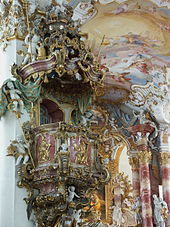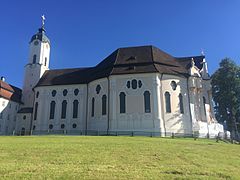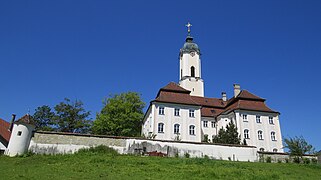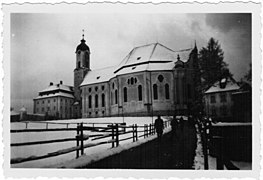Wieskirche
| Wieskirche / Pilgrimage Church of the Scourged Savior on the Wies / Pilgrimage Church on the Wies | |
|---|---|
|
UNESCO world heritage |
|
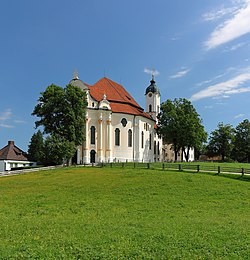
|
|
| The Wieskirche near Steingaden |
|
| National territory: |
|
| Type: | Culture |
| Criteria : | (i) (iii) |
| Reference No .: | 271 |
| UNESCO region : | Europe and North America |
| History of enrollment | |
| Enrollment: | 1983 (session 7) |
The Wieskirche is a remarkably lavishly decorated pilgrimage church in the Wies part of the Steingaden community in the so-called Bavarian “ Pfaffenwinkel ”. The full name of the Wieskirche is the pilgrimage church of the Scourged Savior on the Wies . The church is located in the diocese of Augsburg . The patron saint of the church is St. Joseph .
The pilgrimage church "To the Scourged Savior" in Freising is also known as the "Wieskirche", while the subsidiary church of the Holy Cross in Berbling is called "Kleine Wies". The parish churches of St. Ulrich in Seeg and St. Gordian and Epimachus in Stöttwang as well as the Sebastian Chapel in Wertach and the St. Anna Chapel of the Buxheim Monastery also claim this latter title .
history
The founding of the church goes back to a pilgrimage that began in 1739. It arose from the veneration of a statue of the scourged Savior , which was made in 1730 by Father Magnus Straub and brother Lukas Schweiger in the Steingaden Monastery in Upper Bavaria . The statue was carried during the Good Friday procession of the monastery in 1732–34, but in 1738 it came into the private possession of a farmer on the Wies , the location of the monastery’s summer and rest home a few kilometers southeast of the village. On June 14, 1738, the farmer Maria Lory noticed a few drops in the figure's eyes that she thought were tears. In the following year 1739, answers to prayer and small pilgrimages to the image of the Savior led to the construction of a small field chapel. In 1744, permission was obtained to read mass in the chapel, giving the pilgrimages the official blessing of the church.
Today's Wieskirche was built from 1745 to 1754 by the brothers Johann Baptist and Dominikus Zimmermann under the direction of Abbot Marinus II. Mayer in the Rococo style. The construction brought the Steingaden monastery into great financial difficulties. The construction costs rose from the originally estimated 39,000 fl to 180,000 fl. Together with other obligations, this led to an overall financial burden from which the monastery never fully recovered until its dissolution during the secularization in 1803.
It is often rumored that the Bavarian state planned to auction or demolish the Wieskirche in the course of secularization, and only local farmers managed to preserve the building. On the contrary, it can be proven that the repeal commission of 1803 - against the economic concerns of the Steingaden abbot - expressly spoke out in favor of continuing the pilgrimage in the Wies.
In 1983 the Wieskirche was declared a World Heritage Site and restored from 1985 to 1991 for 10.6 million DM . Today more than a million people attend church each year. It is a regular venue for church music concerts.
The main festivals of the Wies are: on May 1st the opening of the pilgrimage year, on June 14th or the following Sunday the festival of Christ's tears (memory of the miracle of tears and the origin of the pilgrimage), the Guardian Angel festival on the first Sunday in September to commemorate the consecration of the church and the feast of the Brotherhood of the Scourged Savior on the Wies on the second Sunday in October. The charity and Easter liturgy are also celebrated in the Wies. At the church there is the “Confraternitas Domini Nostri Flagellati” (Brotherhood of the Scourged Savior on the Wies), whose members are dedicated to the special veneration of the Scourged Savior. Today it has over 350 members, consisting of priests and lay people.
Furnishing
The altarpiece comes from the Munich court painter Balthasar Augustin Albrecht .
The four figures of the great theologians of the West ( Hieronymus , Ambrosius , Augustine and Gregory the Great ) are the mature work of the Tyrolean sculptor Anton Sturm .
The flattened dome ceiling is painted with a trompe l' oeil fresco.
To the east of the tower is a baroque extension that served the Abbots of Steingaden as a summer residence. The 4-6 fathers who provided pastoral care to the pilgrims also lived in this extension.
organ
The organ goes back to a two-manual slide organ with 23 registers , which had been built in 1757 by Johann Georg Hörtich with a mechanical action mechanism and probably with a short octave in the southern German-Austrian tradition. Very little is known about the instrument itself.
This work was replaced in 1928 by the organ builder Willibald Siemann with the newly built Opus 441. This instrument with two manuals and 27 registers had a pneumatic action in accordance with the taste of the time . In order to accommodate the extended stock of pipes, the housings of the Rückpositive were extended to the rear. The concept was considered modern and trend − setting in terms of organ movement and the organ was now also "Bach − compatible".
Built in 1959 Gerhard Schmid from Kaufbeuren in the past Rococo housing of Dominic Zimmermann a new dreimanualiges instrument with 43 registers to abrasive loading, with mechanical key and pneumatic key action . A swell was added in the substructure of the main housing. A modern gaming table was also newly built . Around 600 pipes were taken from the historical organ from 1757, as well as some registers that the Siemann company had added in 1928. With this new building, the stylistic tendency was approaching the Baroque period again.
In 2010, master organ builder Claudius Winterhalter from Oberharmersbach commissioned a new building, as neither a conversion of the Schmid organ nor a reconstruction of the original instrument was an option. During the planning phase, it emerged that some historic organ parts, such as the modified, richly inlaid console case and a box with pipes from the Hörtich organ, which represented an “attic find” , could be included from the possession of Gunnar Schmid . In total, 475 pipes from the former Hörtich organ as well as 41 pipes from Siemann were integrated into the concept of the new Wies organ. The carpenter's case was retained and restored. The historic gaming table housing from 1757 has been restored and supplemented in order to obtain a modern gaming table with contemporary dimensions as well as a graceful and attractive gaming table. The new arrangement gave the organ a southern German sound characteristic, which was moderately expanded with other stylistic elements in order to meet the liturgical demands and modern concerts.
The instrument has 42 registers on three manuals and a pedal . The game actions are mechanical, the stop actions mechanical and electrical.
|
|
|
|
||||||||||||||||||||||||||||||||||||||||||||||||||||||||||||||||||||||||||||||||||||||||||||||||||||||||||||||||||||||||||||||||||||||||||||||
- Coupling : II / I, III / I, III / II, I / P, II / P, III / P
- Secondary and effect registers : glockenspiel, 2 tremulants
- Playing aids : swell step, setting system
Bells
Seven church bells hang in the tower ( strike tone sequence: f 1 –as 1 –b 1 –c 2 –es 2 –f 2 –tot 2 )
Four of the bells form a coherent baroque peal (as 1 –c 2 –es 2 –ges 2 ). It was cast by Abraham Brandtmair and Franziskus Kern from Augsburg in 1750/51/53.
In 1964 the Hofweber bell foundry from Regensburg added three bells to its inventory.
The Anna bell (bell 2) acts as the angelus bell at 6:00, 12:00 and 18:00 ; in the evening the small death bell follows . Outside of Holy Week, every Friday at 3 p.m., the large Trinity bell reminds of the hour of Christ's death. To ring in the Sundays, Saturdays at 3:00 p.m., the four-part baroque bells sound like 15 and 5 minutes before the Sunday masses. A motif made up of three bells rings on weekdays (b 1 –c 2 –es 2 ). The full bells are reserved for high parties.
- Exterior views
See also
literature
- Gottfried Fellner (editor): The Wieskirche - pilgrimage to the scourged Savior , texts by Hans, Johann and Mechthild Pörnbacher, pictures by Wilfried Bahnmüller. 2016. ISBN 978-3-7954-3059-7
Web links
- Homepage
-
 UNESCO entry on the website of the UNESCO World Heritage Center ( English and French ).
UNESCO entry on the website of the UNESCO World Heritage Center ( English and French ). - Wieskirche. In: arch INFORM .
- German Commission for UNESCO: UNESCO World Heritage pilgrimage church “Die Wies” - harmony of art and landscape in Rococo style
- Baroque bells: https://www.youtube.com/watch?v=wHxKmxdeyrE
- Full bells: https://www.youtube.com/watch?v=TUUv92fG7Tc
Individual evidence
- ↑ The name used by UNESCO is: Pilgrimage Church of Wies
- ^ Entry Wies, Parish Steingaden: To the Scourged Savior in: Christian Schreiber: Pilgrimages through the German land - A pilgrimage to Germany's holy places . Sankt Augustinus Verlag, Berlin 1928, page 36f.
- ↑ Hans-Josef Bösl: Gilbert Michl (1750-1828), the last abbot of Steingaden - A life between the Enlightenment and secularization. In: Sankt Barbara Abensberg - How it was and is. Abensberg 2005, pp. 39-68
- ↑ “As long as the election tour exists, and it exists in the spirit of the people in the most vivacious manner, its abolition can be decided not to be advisable. Until then, however, the buildings or even just a part of them can be thought of as non-salable. This choice is also a real boon for this inaccessible area. And it would be even less advisable to take them away without offering the local residents new sources of food. ”(Oberndorfer, the repeal commissioner responsible for Steingaden, quoted from: Stutzer / Fink: Die earthische und die himmlische Wies, Rosenheim, 1982, ISBN 3-475 -52355-8 )
- ↑ The Brotherhood of the Scourged Savior on the Wies
- ^ Father Georg Kirchmeir: The Wies: pilgrimage church to the scourged Savior. Church Leader, page 40
- ^ Christian Vorbeck: The organ builders Martin Binder and Willibald Siemann. Siebenquart Verlag Dr. Roland Eberlein, Cologne 2013, ISBN 978-3-941224-02-5 .
- ↑ Description of the concept and the organ
- ↑ Markus Zimmermann: The Winterhalter organ of the Wieskirche . In: Ars Organi . tape 58 , 2010, ISSN 0004-2919 , p. 232-237 .
Coordinates: 47 ° 40 ′ 48 ″ N , 10 ° 54 ′ 4 ″ E


